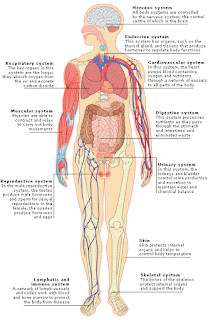Homeostasis is the body's way of maintaining equilibrium and the circulatory and respiratory systems ensure every cell can maintain it. Oxygen is provided to blood cells after being inhaled by the respiratory system, through the heart and the circulatory system. Without these systems working together, oxygenated blood wouldn't flow throughout the body. The nervous system helps the brain pick up on stimuli which causes the body to pick up on varied information, from essential organ functions to creativity. The endocrine system releases hormones into the body that trigger different functions that help the body reach homeostasis. The digestive system breaks down food we eat into energy cells can use and undigested food is removed as waste through the excretory system. The immune system use varied defenses to protect the body from pathogens that can do harm to it. Finally the lymphatic system collects waste throughout the body to get rid of any toxins.
 |
| Homeostasis when speaking in general terms. This can apply to many things for example blood glucose levels and body temperature |
 |
| This is a picture of the 6 systems mentioned above, and more to help the body function! |
I want to learn more about the body's reactions to foreign invaders or pathogens. I think its really amazing how we have all these "lines of defenses" in our bodies and wonder how much fighting it would take for these reactions to be worn down over time. My grandmother is fighting a lung disease because her lungs are deteriorating and I want to know what has caused this since something has gotten through all of her immune system defenses.
Now that the year is come to an end, I look at all of my messy binders with paper spilling out of them and I'm thankful that I have this blog to organize my year's work in biology. I take pride in our unit reflections, my favorite being Unit 9 reflection, because I spent so much time writing it and even after it accidentally got deleted I rewrote it again at 11 pm, almost matching its original quality. Even though I procrastinated alot on it, I'm proud of my Genetics Infographic and this semester I even fixed my Procrastination problem through my 20 time project(there are many progress posts but here is my 20%time wrap up and reflection)! Also looking back at my New Year's Goals, I have met my goal for biology, because I have truly understood most of the material over the course of this year.